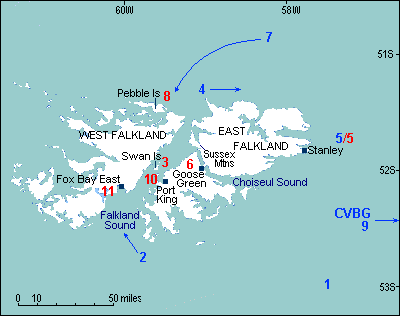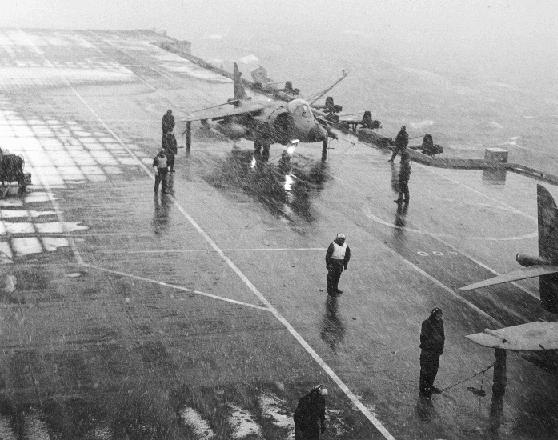
Summary
of Main Events
CVBG - CV
Hermes, Invincible; DD Glamorgan,
Coventry, Glasgow; FR Alacrity, Arrow,
Brilliant, Broadsword, Yarmouth; RFA Fort
Austin, Olmeda, Resource; with SBS and
SAS
1.
SHEFFIELD sank
(10th)
2. Alacrity entered Falkland
Sound from
the south (10th)
3. Alacrity sank Isla de los
Estados off Swan Is (10th/11th)
4. Alacrity met Arrow
and headed back to
CVBG (10th/11th)
5. Glasgow damaged
off Stanley/Argentine aircraft
lost - [a16,a17,a18] Skyhawks
(12th)
6. Argentine aircraft lost at
Goose Green -
[a19]
Skyhawk (12th)
7. PEBBLE ISLAND OPERATION (11th-15th)
(1)
SAS Boat Troop patrol ashore to
reconnoitre (11th/12th)
(2)
Hermes,
Broadsword and Glamorgan approached and D
Sqdn SAS landed by No.846 Sea Kings (14th)
8.
Pebble
Island
Installations and aircraft destroyed and
force returned to CVBG; Argentine
aircraft lost -
[a20-25] Pucaras,
[a26-29] Mentors,
[a30]
Skyvan (14th/15th)
9. British aircraft
lost east of Falklands - [b7] Sea King
(12th)
10. Argentine cargo
ship Rio Carcarana attacked and beached
in Port King (16th)
11. Argentine transport Bahia
Buen Suceso damaged at Fox
Bay East (16th)
In the build-up
to the landings at San Carlos, Admiral
Woodward's destroyers and frigates continued to wear down
the invaders and D Sqdn SAS made an important contribution with its Pebble
Island raid. On Monday 10th, as submarine "San Luis" made her
last reported and equally unsuccessful attack on ships of
the Task Force and "Sheffield" finally sank, "Glasgow" (Sea
Dart) and "Brilliant" (Sea Wolf) took over as
type 42/22 combination from "Coventry" and
"Broadsword" and continued their radar picket
and bombardment duties off Stanley. That night as
"Arrow" moved to the north end of Falkland
Sound, sister ship "Alacrity" prepared to sail
right through from the south for the first time to flush out any supply
ships. As she passed up the Sound, "Alacrity"
detected a small ship apparently heading for Port
Howard, and using her
single 4.5 inch, illuminated with star shell. Refusing to
stop, the target was engaged in the only surface
action of the war and after a number of hits,
exploded and sank with heavy casualties. Reportedly there
were only two survivors from what turned out to be the
naval transport "ISLA DE LOS ESTADOS" carrying fuel and military
supplies. "Alacrity" carried on through to meet
"Arrow", and on Tuesday morning, both ships headed back to the
carriers. Later that day, "Yarmouth" also
returned from her attempts to tow "Sheffield"
out of the TEZ.
On Wednesday afternoon (12th) with "Glasgow" and
"Brilliant" still off Stanley, eight A-4B
Skyhawks of Grupo 5 were sent in to attack the bombarding
ships. The first flight came in low, and as
"Brilliant"
fired her Sea Wolf automatically for the first time in
anger, two aircraft exploded in the air, a third crashed
in to the sea trying to escape and the fourth dropped its
bomb without hitting, and got away [a16, a17, a18]. The second flight of four came in
some minutes later, but for technical reasons Sea Wolf
could not fire, and this time "Glasgow"
was hit by a bomb
which went in one side and out the other without
exploding or causing any casualties. Although the damage
was not severe, she had to withdraw to the CVBG for
repairs that took a number of days and eventually became
the first British warship to return home. Meanwhile as
these Skyhawks returned home, they passed too close
to Goose Green and
"Glasgow's"
attacker was shot down by Argentine AA [a19].
Just a week before the
landings, a raid was mounted by D Sqdn SAS on the airstrip and facilities at Pebble
Island,especially
to destroy the ground attack Pucaras based there. First
of all men of the Squadron's Boat Troop were put ashore
over Tuesday
night to reconnoitre
the area and three days later on Friday 14th, "Hermes" and escort
"Broadsword" together with
"Glamorgan" in the fire support role left the
CVBG, and passing to the north, approached Pebble Island
by night. As
"Glamorgan" closed in to gunfire range,
"Hermes" flew off the 48 SAS attackers and NGFO
team in her No.846 Sea Kings to be guided in at midnight by the awaiting patrol. After a
forced march to the airstrip, the attack went ahead led by Captain Hamilton,
and all the aircraft
there put out of action or destroyed by prepared charges.
A fuel depot, ammo dump and radar installation were also
destroyed. All this time "Glamorgan" provided
gunfire support, and as the raiders withdrew, a brief
Argentine counter-attack was halted when the officer in
charge was shot. With two men slightly wounded the SAS
were safely picked up again by the helicopters. The raid
was a complete success and the Argentines not only lost
six Pucaras of Grupo 3 [a20-25], four T-34C Mentors [a26-29] of CANA 4 Esc and one Coast Guard
Skyvan
[a30], but also the
use of the airstrip at a crucial time. Now into Saturday morning, the warships returned to the
CVBG, but "Glamorgan" soon moved on to other
duties. Although bad weather had
restricted fixed wing flying earlier in the week, by Wednesday 12th it had improved sufficiently for
high level bombing attacks to be made on Stanley, the same day a No.826 ASW Sea King
from "Hermes" ditched near the CVBG with engine
failure [b7]. The
crew were saved. The next main action took place over the
weekend as Sea Harriers continued to bomb Stanley. On Saturday night "Brilliant's" Lynx
failed in an attack on the transport "Bahia Buen
Suceso" in Fox Bay East, but "Hermes"
aircraft more than made up for this next day. In the
middle of Sunday 16th, two No.800 Sea Harriers bombed and strafed
the blockade running cargo ship "Rio Carcarana" (8,500
grt) at anchor off Port King and although there were no casualties, she
caught fire, was beached and abandoned, finally to be
destroyed by "Antelope's" Lynx a week later.
Another two aircraft caught the "Bahia Buen
Suceso" still
at Fox Bay East alongside the jetty and raked her with
cannon fire. Bombs were not used because of the ship's
proximity to the settlement, but the damage was enough to
deny her use by the Argentines, and she stayed there
until after the war.Following
the Pebble Island raid, HMS Glamorgan took on the job of
convincing the Argentines that any landings would take
place on East Falkland, south of the capital. For a
number of nights, she bombarded Stanley and moved down the
coast as far as Choiseul Sound carrying out a variety of deception
activities. Other SBS and SAS operations were no doubt
taking place all this time, and over Sunday night "Alacrity" sailed through Falkland Sound
again and landed an SBS/NGFO team by Gemini near Sussex
Mountains which overlooks the landing beaches around San Carlos Water.

Sea
Harriers of No 800 NAS aboard HMS Hermes in
"typical foul weather" in the Atlantic
during winter.
Probably taken post-war, but
typical of South Atlantic conditions during the
Falkland's War (Courtesy - MOD, Navy)
|

